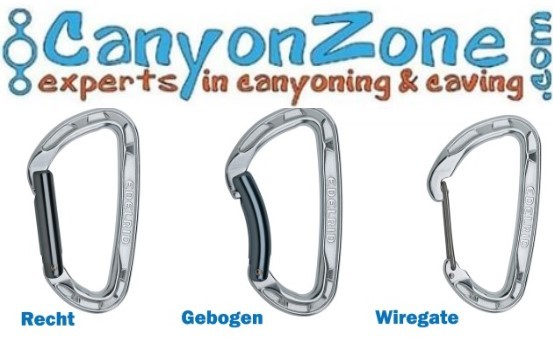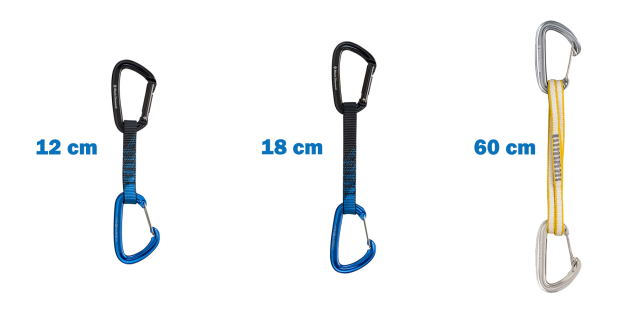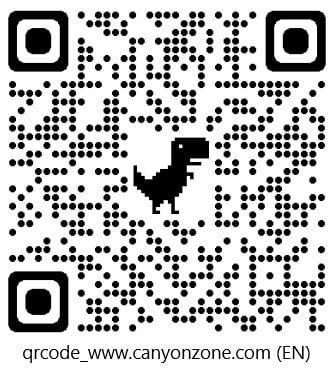This is how you choose a climbing set / quickdraw!
Determining what your climbing set should consist of is an important point of attention. Are you going to make a canyon trip or into a cave and study which terrain you are crossing. Once you have an idea of this, you can then assess climbing sets on three points whether they fit well with your activity.
- What kind of carabiner/snapper am I looking for?
- What are the different slings and which length is convenient for me?
- How many climbing sets do I need?
Check out CanyonZone's range of climbing Quickdraw.
Type of carabiners or snappers
 The carabiners used in climbing sets are actually always called snappers.
The carabiners used in climbing sets are actually always called snappers.
Broadly speaking, there are three types of snappers that are used in climbing sets.
Straight
Curved
Wiregate
Straight snappers can often be found in a climbing set together with a curved snapper. The straight snapper is then at the top of the climbing set for clipping into the rock wall. The curved snapper is located at the bottom for easy clipping of the climbing rope. You can easily recognize a straight snapper by the closure because it is completely straight. Straight snappers are also regularly used in combination with a wiregate snapper.
Curved snappers are curved as mentioned above to make it easier to clip in the climbing rope. You can recognize it by the curved closure.
Both curved and straight snappers have a drawback. In the event of a large blow, such as with a lead climb, these can open very briefly. This almost never happens, but it can temporarily reduce the snapper's strength at that point.
Wiregate snappers have a metal gate as closure. This closure is lighter and you have less chance of freezing at very cold temperatures than with the other two types of snappers.
The disadvantage of a wiregate snapper is that you are dealing with a snapper without a snagfree closure or keylock closure. The metal gate rests in a notch in your snapper when closed. This notch can lead to frustration when you want to clip out the snapper. You can linger behind the anchor point or the rope lingers behind the notch. Some wiregate snappers are therefore fortunately equipped with a nose that should prevent you from getting caught behind the notch as you can see below.
Dimensions and weight of a snapper
When choosing a snapper, the dimensions and weight are also points of attention. Small snappers can save a lot of weight, but are also more difficult to use. Especially if you have big hands.
Slings from a climbing set
Which slings and the length of slings are optimal for your activities. These slings are often also called express slinges or 'dogbones'.
When climbing, the following length slings are usually used:
10-12cm; This length is sufficient for relatively straight routes. A set of six climbing sets is often sufficient.
17-18cm; You use these length of slings more if the route is slightly more erratic. It is wise to always bring at least one climbing set with this length of sling. You also use this at points where a short climbing set cannot hang freely.
If you are going to climb climbing routes of multiple rope lengths or for climbing the Big Wall, you probably already have some more experience in using climbing sets. With this experience, you may want to determine the length of the climbing sets yourself by purchasing two separate snappers and, for example, a separate sling of 60 cm. A longer sling is effective in reducing rope friction at the intermediate points, but is heavier and takes up more space when transporting.
Material Slings
Slinges are mainly made of nylon, polyester or dyneema. Nylon slings are usually the cheapest of the three, stronger than polyester and more elastic. However, nylon is less resistant to UV radiation than polyester. Dyneema is the lightest, strongest and best against UV radiation. Dyneema only has a higher price.
Width Slinges
 The width of a sling is often related to the material from which it is made. There are dyneema slings with a width of 8 mm, these are made as light as possible. The only drawback is that it is less comfortable to grip these thin slings when you want to hang out to read the route. The wider slings are available up to about 25 mm.
The width of a sling is often related to the material from which it is made. There are dyneema slings with a width of 8 mm, these are made as light as possible. The only drawback is that it is less comfortable to grip these thin slings when you want to hang out to read the route. The wider slings are available up to about 25 mm.
Number of climbing sets
Determining the number of climb sets depends on the route you are going to take. Therefore, always consult a climbing topo in advance. For safety, it is smart to take 1 or 2 more climbing sets with you than are described in the climbing topo. If you plan to use climbing kits for your anchorage as well, add them to the total.
Overview Knowledge base General canyoning and caving equipment : Go back.
CanyonZone
-
- Experts in canyoning & caving gear - ship worldwide
-
- New items in assortment
- Special offers
- Pre-ordering 2025
- NEW - Petzl Canyoning / Caving Line 2025
- 2nd hand canyoning caving articles
- Items / packages customer specific
- Giftcards of CanyonZone
-
- Canyoning (basic) equipment
- Canyoning equipment packages
- Luggage / Travel Bags
-
Canyoning Neoprene clothing
- Size charts by Brand
- Aventure Verticale (AV) size charts
- CE4Y neoprene size charts
- GUARA neoprene size charts
- Seland neoprene clothing size charts
- Newex neoprene size charts
- NRS neoprene size charts
- Vade Retro neoprene size charts
- Custom made neoprene wetsuit, required size data
- Canyoning Wetsuits
- Protective Canyoning Clothing
- Canyoning Neoprene Headgear
- Canyoning Drysuit / Undersuit
- Canyoning Neoprene shirts & shorts
- Canyoning Knee - elbow protectors / pads
- Canyoning Neoprene gloves
- Canyoning Neoprene socks
- Canyoning shoes
- Harnesses & Accessories
- Helmets outdoor sports
- Carabiners & maillons
- Descend devices
- Ascending / Rise along rope
- Pulleys
- Rope & webbing slings
- Anchoring & accessories
- Via Ferrata / Klettersteig sets
- Outdoor Gloves / (ice-)canyoning, caving, via ferrata
- Canyoning Back Packs, bags & duffels
- Drybags & Kegs, Boats
- Outdoor Knives & Scissors
- Safety in outdoor sports
- First Aid / Medical Articles
- Rescue in outdoor sports
- Camping, Bivouac & Backpacking
- Winter- / Ice Canyoning
-
Canyoning Books & Topographic Maps
- Map Pouch
-
Canyoning Guide Books
- Australia
- Austria
- France (including Corsica and La Reunion)
- Germany
- Greece (including Crete) / Balkans
- Israel
- Italy (including Sardinia)
- Jordan / Middle East
- Morocco
- New Zealand & Australia
- Portugal (including Madeira and Azores)
- Scandinavia
- Slovenia
- Spain (including Canary Islands and Majorca)
- United Kingdom (UK) / Scotland
- United States of America
- South America
- Switzerland
- Turkey
- Canyoning Techniques & Skills
- Canyoning Maps
- Outdoor Children's Books
- Outdoor DVDs
- Via Ferrata / Klettersteig books
- Repair & Maintenance
- Miscellaneous items outdoor sports
-
- Especially for Ladies
- Especially for Children
- Especially for Instructors and Guides
- Especially for Outdoor Sports Companies
- Especially for Underwater / Cave diving / Diving
-
- Caving (basic) equipment
- Caving equipments packages
- Caving Suits / Overalls
- Caving Under Suits
- Caving Boots / Wellies
- Caving Socks
- Caving Knee- and Elbow Pads
- Caving Gloves
- Headlamps & torches
- Caving Bags & BackPacks
- Tents and Bivi bags
- Caving & Potholing Books
-
-
Climbing related gear: on request
-
- Services
-
- CanyonZone New(s)
- CanyonZone Customer Service
- Contact about Assortment
- Business ordering at CanyonZone
- About CanyonZone
- CanyonZone's FAQ
- CanyonZone's Knowledge Base
- About CanyonZone, owner Gertjan van Pelt
- Works together with
- Link exchange
-
- Privacy
- Terms and Conditions
-
Terms and Conditions Rental
-


